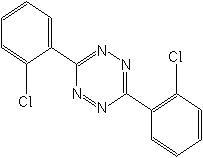-
Physical Properties
Molecular weight:303.1; Physical form:Odorless, magenta crystalline solid.. Density:1.51 (20 °C); Melting point:182.3 °C; Flash point:Low flammability; Vapour pressure:1.3×10-4 mPa (25 °C) (gas saturation and glc); Henry constant:1.97×10-4 Pa m3 mol-1 (calc.); Partition coefficient(n-octanol and water):logP = 4.1 (25 °C); Solubility:In water 2.5 μg/l (pH 5, 22 °C). In dichloromethane 37, acetone 9.3, hexane 1, ethanol 0.5 (all in g/l, 25 °C).; Stability:The a.i. and formulated products are stable to light, heat and air; on hydrolysis (22 °C), DT50 248 h (pH 5), 34 h (pH 7), 4 h (pH 9).
-
Toxicology
Oral:Acute oral LD50 for rats >5200 mg/kg. Percutaneous:Acute percutaneous LD50 for rats >2100 mg/kg. Mild eye and skin irritant. Inhalation:LC50 (4 h) for rats >9 mg/l air. Phytotoxicity:May cause slight injury to glasshouse roses. May cause a slight pink deposit on petals of white or pale flowers.
-
Environmental Profile
Ecotoxicology: Algae:Not toxic to Scenedesmus panonicus up to limit of solubility.Bees:Acute LD50 (oral) >20 μg/bee; LC50 (contact) >1500 ppm.Birds:Acute oral LD50 for mallard ducks >3000, bobwhite quail >7500 mg/kg. Dietary LC50 (8 d) for mallard ducks and bobwhite quail >2000 mg/kg diet.Daphnia:LC50 (48 h) >1.45 μg/l (limit of solubility).Fish:LC50 (96 h) for rainbow trout >0.015, bluegill sunfish >0.25 mg/l (limits of solubility). Environmental fate: Animals:In mammals, undergoes metabolism by hydroxylation and exchange of the chlorine atoms on the rings for methylthio groups. Following oral administration, excretion occurs within 24-48 hours in the urine and faeces.Soil:In soil, the major degradation route leads to 2-chlorobenzoic acid, and finally to CO2. DT50 in soil 65-85 d (15 °C), 28-56 d (25 °C), depending upon soil type. However, in laboratory studies, no leaching occurs. In wPlant:In metabolism studies, unchanged clofentezine was the major extractable residue. Trace amounts (4%) of 2-chlorobenzonitrile, the major photodegradation product, were also detected. WATER SOLUBILITY: Formulation completely miscible in water
-
Transport Information
Signal Word:CAUTION; Hazard Class:III (Slightly hazardous)

 0
0 Subscribe
Subscribe
